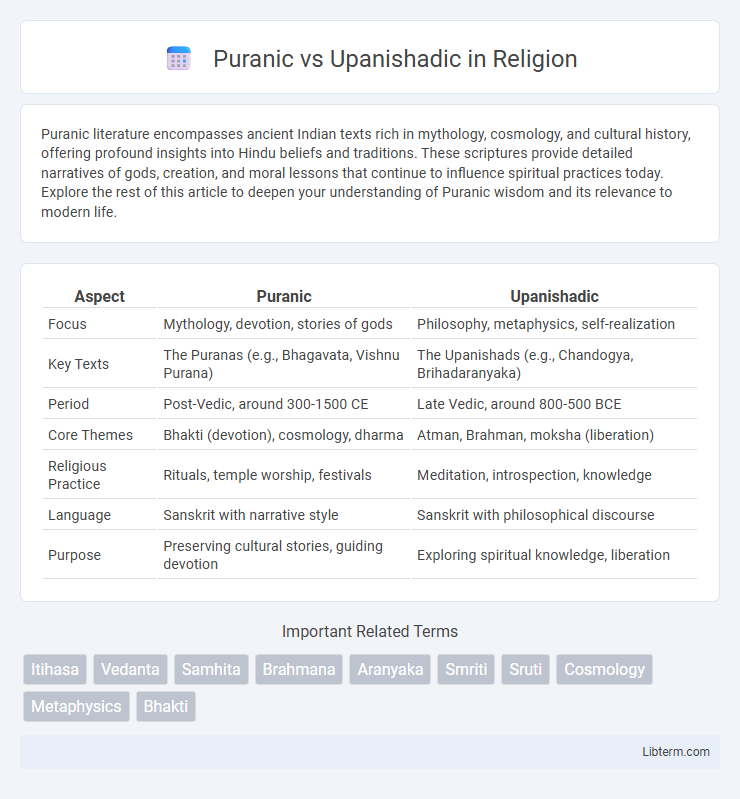Puranic literature encompasses ancient Indian texts rich in mythology, cosmology, and cultural history, offering profound insights into Hindu beliefs and traditions. These scriptures provide detailed narratives of gods, creation, and moral lessons that continue to influence spiritual practices today. Explore the rest of this article to deepen your understanding of Puranic wisdom and its relevance to modern life.
Table of Comparison
| Aspect | Puranic | Upanishadic |
|---|---|---|
| Focus | Mythology, devotion, stories of gods | Philosophy, metaphysics, self-realization |
| Key Texts | The Puranas (e.g., Bhagavata, Vishnu Purana) | The Upanishads (e.g., Chandogya, Brihadaranyaka) |
| Period | Post-Vedic, around 300-1500 CE | Late Vedic, around 800-500 BCE |
| Core Themes | Bhakti (devotion), cosmology, dharma | Atman, Brahman, moksha (liberation) |
| Religious Practice | Rituals, temple worship, festivals | Meditation, introspection, knowledge |
| Language | Sanskrit with narrative style | Sanskrit with philosophical discourse |
| Purpose | Preserving cultural stories, guiding devotion | Exploring spiritual knowledge, liberation |
Introduction: Understanding Puranic and Upanishadic Literature
Puranic literature encompasses a vast collection of ancient Hindu texts that narrate myths, legends, and cosmology, serving as a key source for cultural and religious traditions. Upanishadic literature, forming the philosophical core of Vedanta, explores metaphysical concepts such as Brahman (ultimate reality) and Atman (self), emphasizing meditation and knowledge for spiritual liberation. Both Puranas and Upanishads significantly shape Hindu thought, with Puranas providing narrative frameworks and Upanishads offering profound philosophical insights.
Historical Origins of the Puranas and Upanishads
The Puranas originated between 300 and 1500 CE as extensive mythological texts codifying Hindu cosmology, genealogies, and rituals, reflecting the socio-religious milieu of the Gupta and post-Gupta periods. In contrast, the Upanishads emerged earlier, around 800 to 300 BCE, during the late Vedic period, emphasizing philosophical introspection and metaphysical concepts such as Brahman and Atman. Their historical origins highlight the Puranas' role in popularizing mythic traditions and the Upanishads' foundational contributions to Vedantic thought and spiritual inquiry.
Core Philosophical Themes: Mythology vs. Metaphysics
Puranic texts emphasize mythology, narrating cosmic origins, genealogies of gods, and moral stories that reinforce dharma through vivid symbolism and rituals. Upanishadic literature centers on metaphysical inquiry, exploring the nature of ultimate reality (Brahman), the self (Atman), and the principles of consciousness and liberation (moksha). This divergence highlights the Puranas' role in religious storytelling and cultural tradition, while the Upanishads drive abstract philosophical thought and spiritual introspection.
Narrative Structure: Storytelling in Puranas versus Dialogues in Upanishads
Puranas employ elaborate narrative structures rich in myths, genealogies, and cosmological stories, creating an immersive storytelling experience rooted in devotion and moral lessons. Upanishads primarily utilize philosophical dialogues and dialectical exchanges between teachers and students, emphasizing metaphysical inquiry and self-realization. This contrast highlights Puranas' focus on accessible mythic lore versus Upanishads' pursuit of profound spiritual knowledge through reflective discourse.
Concept of God: Polytheism vs. Monism
Puranic texts emphasize polytheism, portraying a pantheon of gods with distinct personalities, roles, and mythologies, reflecting a diverse and devotional approach to divinity. In contrast, the Upanishads advance monism, teaching that the ultimate reality, Brahman, is a singular, formless, and infinite principle underlying all existence. This philosophical shift redefines God from multiple deities to an impersonal, unified cosmic spirit.
Spiritual Practices and Rituals Explained
Puranic texts emphasize detailed spiritual practices and elaborate rituals involving deity worship, temple ceremonies, and festivals aimed at devotion (bhakti) and cosmic order (dharma). Upanishadic literature centers on inner spiritual knowledge, meditation, and self-realization (atma-jnana) through introspective methods, emphasizing liberation (moksha) beyond external rituals. The contrast highlights Puranic practice as ritualistic and community-oriented, while Upanishadic teachings prioritize philosophical inquiry and personal enlightenment.
Influence on Indian Culture and Society
The Puranic texts significantly shaped Indian culture by preserving and popularizing mythology, rituals, and social norms that influenced festivals, temple worship, and caste structures. Upanishadic literature, centered on philosophical inquiry and metaphysical concepts like Brahman and Atman, deeply impacted spiritual thought, meditation practices, and the development of diverse schools of Indian philosophy. Together, these texts shaped not only religious practices but also the ethical and intellectual fabric of Indian society.
Ethical Teachings and Moral Lessons
Puranic texts emphasize ethical teachings through vivid mythological stories that illustrate virtues such as dharma (duty), karma (action), and devotion to deities, fostering moral values like righteousness and compassion. Upanishadic literature promotes introspective ethical principles by focusing on self-realization, the unity of Atman (soul) and Brahman (ultimate reality), and the importance of truth, non-violence, and self-discipline. Both texts complement each other, with Puranas providing practical moral guidance through narratives and Upanishads offering profound philosophical foundations for ethical living.
Literary Style and Language Differences
Puranic texts predominantly feature a narrative literary style characterized by elaborate storytelling, mythological accounts, and accessible prose designed for a broad audience. In contrast, Upanishadic literature employs a philosophical and meditative style, using concise, symbolic language aimed at exploring metaphysical concepts and spiritual knowledge. The language of the Puranas is often vernacular Sanskrit enriched with poetic elements, while the Upanishads utilize classical Sanskrit with dense, aphoristic expressions focused on contemplation and dialogue.
Lasting Impact: Puranic vs. Upanishadic Thought Today
Upanishadic thought, emphasizing metaphysical concepts like Brahman and Atman, continues to influence contemporary philosophy, spirituality, and yoga practices globally. Puranic texts, rich with mythological narratives and devotional themes, shape popular Hindu worship, festivals, and cultural traditions. Both streams contribute enduringly to Indian religious identity, with Upanishads inspiring introspection and Puranas fostering communal devotion.
Puranic Infographic

 libterm.com
libterm.com